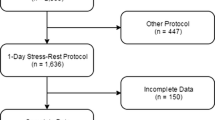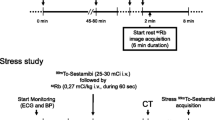Abstract.
The aim of this study was to correlate lung thallium-201 uptake on exercise with 201Tl single-photon emission tomography (SPET) myocardial perfusion imaging, rest and exercise equilibrium radionuclide angiographic and coronary angiographic findings in patients with coronary artery disease (CAD) using a simple, reproducible lung/heart (L/H) ratio that would be easy to use in clinical practice. L/H ratio was defined on the anterior planar image obtained during exercise 201Tl SPET acquisition as the mean counts per pixel in an entire right lung field region of interest divided by the mean counts per pixel in the hottest myocardial wall region of interest. We studied 103 patients. Fifty-nine patients (group I) with <5% likelihood of CAD were used as a reference group. In 44 CAD patients (group II), L/H ratio was compared with 201Tl SPET, radionuclide angiographic and coronary angiographic variables. The group I L/H ratio of 0.35±0.05 (mean ±1 SD) was significantly lower (P<0.001) than the group II L/H ratio of 0.45±0.10. An L/H ratio >0.45 (mean + 2 SD in group I) was considered abnormal. In group II, L/H ratio showed a significant correlation with stress and rest 201Tl perfusion defect size (r = 0.39 and r = 0.42, P<0.01, respectively), but not with extent of ischaemic myocardium. The mean L/H ratio was 0.41±0.10 in patients with one-vessel disease (n = 15), 0.46±0.08 in those with two-vessel disease (n = 17) and 0.47±0.12 in those with three-vessel disease (n = 12), but no significant difference was found between the three subgroups. L/H ratio showed a significant inverse relation with rest and exercise left ventricular ejection fraction (r = –0.37 and r = –0.50, P<0.05 and P<0.001, respectively). Using stepwise multiple regression analysis, exercise left ventricular ejection fraction and previous history of hypertension were the sole two variables independently predictive of the L/H ratio. In conclusion, although lung thallium uptake is usually found to correlate with extent and severity of CAD, increased L/H ratio should primarily be considered as a marker of exercise-induced left ventricular systolic and perhaps diastolic dysfunction, probably independent of the underlying cardiac disease.
Similar content being viewed by others
Author information
Authors and Affiliations
Additional information
Received 14 January and in revised form 22 February 1999
Rights and permissions
About this article
Cite this article
Morel, O., Pézard, P., Furber, A. et al. Thallium-201 right lung/heart ratio during exercise in patients with coronary artery disease: relation to thallium-201 myocardial single-photon emission tomography, rest and exercise left ventricular function and coronary angiography. Eur J Nucl Med 26, 640–646 (1999). https://doi.org/10.1007/s002590050432
Issue Date:
DOI: https://doi.org/10.1007/s002590050432




